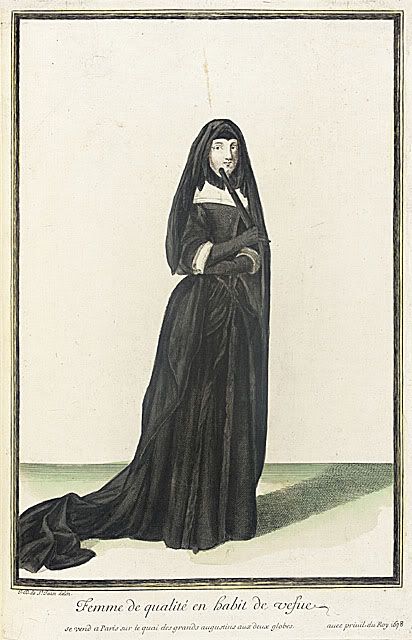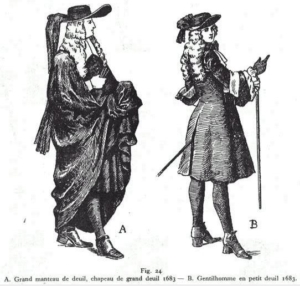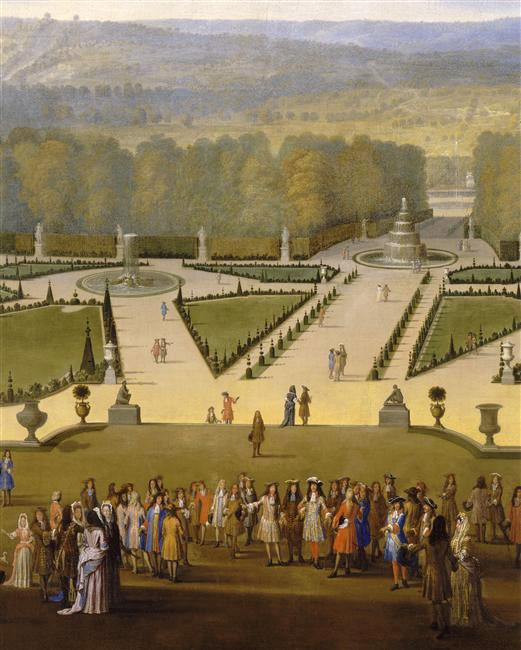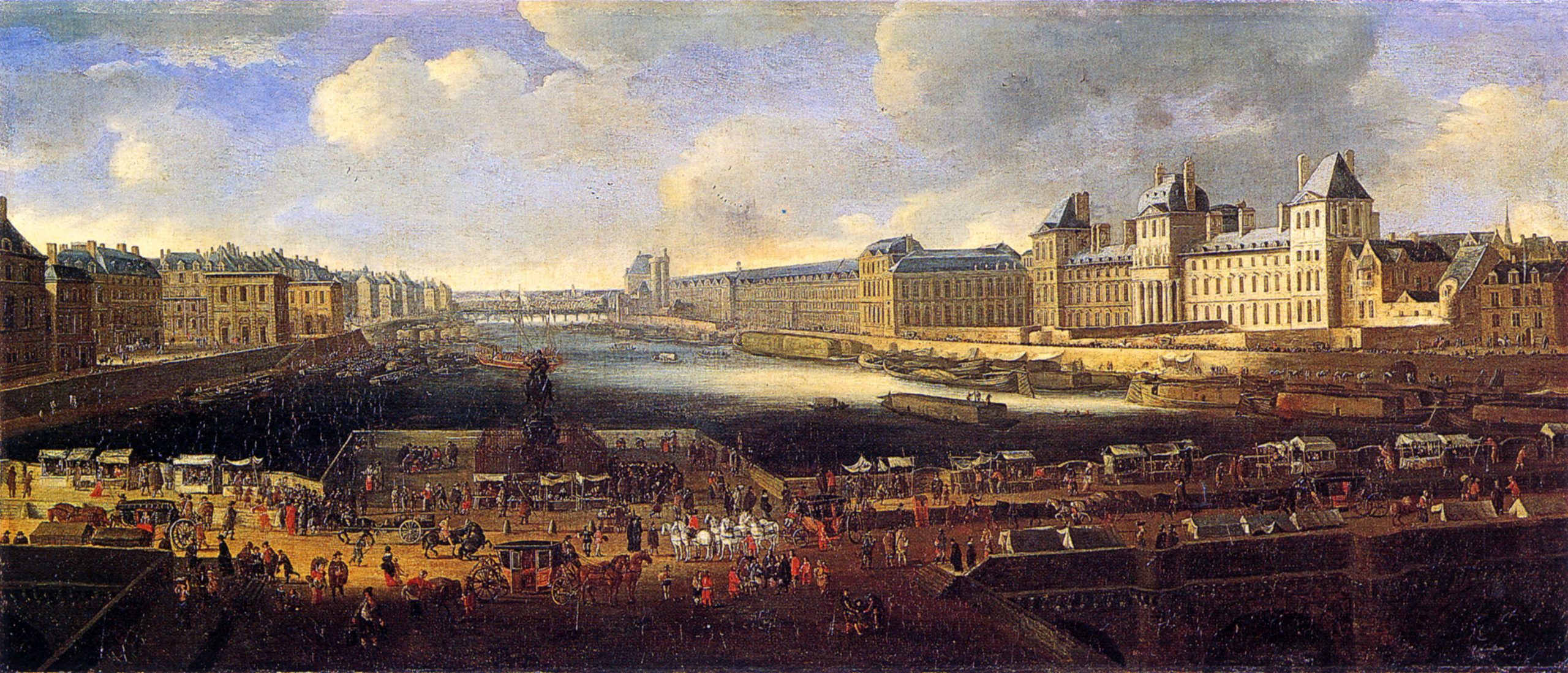Court Mourning
The colours of mourning followed Louis XIV during his long reign of seventy-two years and especially in the last years of his reign, the court hardly got out of mourning. Court mourning followed strict rules of etiquette as well as strict rules of fashion, the latter so much that fabric merchants all over France suffered great losses whenever the court went into mourning.

Court mourning was always announced by the King and consisted of Grand-Mourning, Semi-Mourning and Petit-Mourning. During Louis XIV’s reign the court went into mourning whenever a member of the Royal Family, the Grand Princes or an other Sovereign passed away. Whenever this was the case, certain rooms of the residence the court lodged at, were draped in black, or violet if it were the King’s room. Black was the mourning colour of the court and the Queen, violet was reserved for the King.
During earlier centuries, the Queen would dress in white during the mourning period. The dress code for the King followed the three types of mourning. All violet for the Grand-Mourning, including violet stockings, and no jewellery or adornments were worn, even the buttons of the violet mourning outfits were covered in the same colour. During this period, the King also wore a specific type of sleeves, the pleureuses or weepers. Those garments were usually made of light wool for the summer and serge for the colder months.
After the period of Grand-Mourning, when the time of Semi-Mourning began, the pleureuses were no longer worn and the fabrics became more costly. Silk was worn instead of serge and certain adornments in form of gems were allowed again. The start of the period of Petit-Mourning was marked by white stockings being worn again instead of violet ones.
The length of court mourning depended on who was mourned, but usually it lasted for a whole year. During this year, black was a must for the courtiers and no-one that did not wear black was allowed in presence of the King, even if it was just a brief meeting, All court entertaining was suspended during this time. Mourning was not just a time to actually mourn, but also a time of disputes about precedence and hierarchy.

The outfits of the ladies followed a strict etiquette, in which some were entitled to a mourning train and others not. It’s length depended on the rank and status of the lady. The Queen wore a mourning train, or queue de deuil, of eleven aunes. Daughters of France wore a train of nine aunes, Grand-daughters of France were entitled to seven aunes, Princesses of the Blood to five and the Duchesses to three aunes. Everything below the rank of Duchesse was not entitled to wear a queue de deuil. (The length of a aune depends on the region and time. A Parisian aune was about 0,735 meter.)
For the Gentlemen, their mourning outfits mirrored that of the King, just in black. Buttons and buckles had to be covered with fabrics, as well as their rapiers. The fabric that was worn was mostly wool or variations made with wool. Silks and rich brocades were not permitted and long black cloaks were worn during the Grand-Mourning.
Depending on the rank of a person and their relations to the deceased, a mourner could be allowed to sit by the bed of the one who had passed away or had to stand. Whether a sprinkler of Holy Water was offered or not, depended on the same. Visits to the family of the deceased were expected and condolences stated.
It was not only the nobles of the court who had to follow the mourning dress code, but also the servants. They were provided with black garments fitting for their tasks. Originally only the nobility was allowed to participate in court mourning, but this was extended to all ‘persons of quality’ and later to the general public.
It was the duty of each noble person to provide their own staff with fitting garments, which did cost them a pretty penny at times. It was a chance to show off wealth and thus the nobility made sure their servants would wear the best fabrics for their tasks and standing within the servants hierarchy.

The length and amount of court mourning regularly made the cloth merchants fear for their own life. When the court was in mourning, no new garments were ordered and by the time the court came out of mourning, the rich and expensive fabrics, all the coloured brocades and silks, the merchants had to offer, were mostly outdated already. They had no other choice than to sell the fabrics, which were meant for the court, for a way lower price and suffered great losses due to it. It went so far that whenever court mourning was expected to take place, a lot of dress-makers and fabric-makers lost their employment. A record from 1655 shows that the people of Lyon were in serious need of charity, after the court went into mourning for Philip IV of Spain and all trade with England was stopped due to the plague. The same occurred in 1705, after the death of eldest son of the Petit Dauphin, and in 1711, after the death of the Grand Dauphin. The death of the latter caused so much distraught among the weavers, they sent a ‘protest’ poem to the King himself.
“To the King. Six months of mourning for the Dauphin! Ten years if black clothes would bring him back to life. But at the feet of Atropos as we groan in vain, because he has died of sickness must we die of hunger? Sire, give us work or bread.”
As Louis XIV died in 1715, the city of Lyon and the rest of the France found themselves in the same situation again. The death of the Sun King and the court mourning afterwards, nearly ruined several towns. Petitions were sent to court, begging to have the length of court mourning reduced to half a year instead a full year. The plea was heard and the time of mourning reduced accordingly.




